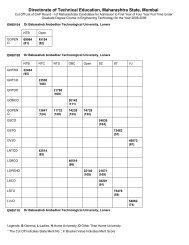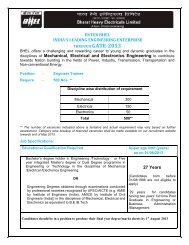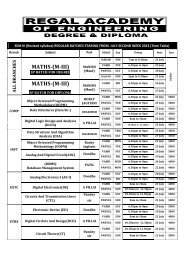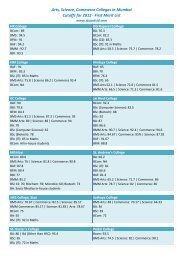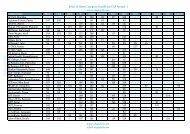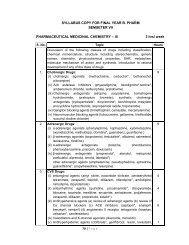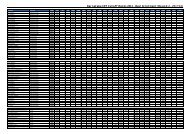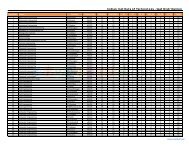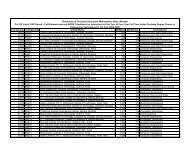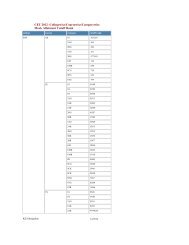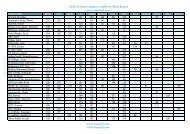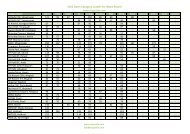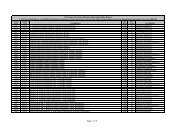Syllabus - Engineering
Syllabus - Engineering
Syllabus - Engineering
Create successful ePaper yourself
Turn your PDF publications into a flip-book with our unique Google optimized e-Paper software.
V SEMESTERMINE ENVIRONMENTAL ENGINEERING – ISub Code : 10MN 52 IA Marks : 25Hrs/ Week : 04 Exam Hours : 03Total Hrs. : 52 Exam Marks : 100PART-A1. Mine Air: Atmospheric air and composition of mine air, MineGases:- Occurrence, properties, detection, measurements and physiologicaleffects.06Hrs2. Study on Fire Damps: Methane content, emission of methane,degree of gassiness of a coal mine, gas blowers, gas outbursts, dealing offiredamp in mines. Methane streaming and layering, methane drainage,testing of firedamp. Problems on mine gases.07 Hrs3. Mine Climate: Physiological effects of mine climate, objective ofmine ventilation, air quantity requirement, pressure, barometric pressure,temperature, sources of heat in mines, moisture content of mine air, effects ofheat and humidity on the miner, cooling power of mine air, psychometry andair conditioning. Problems.06 Hrs4. Air flow through mine openings: Fundamentals of air flow,Reynolds number, laminar and turbulent flow, pressure losses due to frictionand shock resistance, resistance of airways:- laws of mine air friction, coefficientof friction, resistance of roadways in series and parallel, resistanceof leaky airways, characteristic of an airway (or) mine, equivalent orifice,Economic design of an airway. Distribution of air and flow control devices.Problems.07 HrsPART-B32
5. Natural Ventilation: Mechanism, causes, calculation of NaturalVentilation Pressure from air densities, other methods of determining NaturalVentilation Pressure, motive column. Problems on Natural VentilationPressure.06 Hrs6. Mechanical Ventilation: Types of fans, theory, efficiencies,characteristic curves and suitability of fans, selection, testing and outputcontrol of a mine fan. Fans in series and parallel, forcing and exhaustventilation, reversal of air currents, diffusers, evasees, ventury, booster andauxiliary fans. Problems. 08 Hrs7. Ventilation survey: Importance of ventilation survey, types: -qualitative surveying, pressure survey and quantity survey. Simple problems.06 Hrs8. Elements of Ventilation Planning: Objective, steps in ventilationplanning, desirable features of a ventilation system, types of ventilationsystem, quantity requirement, analysis of ventilation cost.06 HrsTEXT BOOKS:1. Elements of Mining Technology Vol II- D.J. Deshmukh, 9 th Edition,Central Techno Publication, Nagpur, 1998.2. Mine Environment and Ventilation – G.B. Mishra, OxfordUniversity Press, 1994.REFERENCE BOOKS:1. Mine ventilation and air conditioning – Howard L. Hartman. WileyInternational, 1976.2. Environmental <strong>Engineering</strong> in Mines – Vutukuri & Lama,Cambridge University Press, Cambridge, 1992.3. Legislation in Indian mines a critical appraisal Vol. I and Vol. II –Prasad and Rakesh. Vivek Publications, Varanasi 1999.4. Mine Ventilation Vol. – II, S. Ghatak, Coalfield Publishers, 1993.5. Numerical Problems on Mine Ventilation, L.C. Kaku, LovelyPrakashan, Dhanbad.6. Basics of Mine Ventilation, P.C. Shyam, Lovely Prakashan,Dhanbad.Scheme of Exam: Total EIGHT questions are to be asked, FOUR fromeach part. The student has to answer any FIVE full questions selecting atleast TWO from each part.33
TEXT BOOKS:1. Elements of Mining Technology Vol. III – D.J.Deshmukh, 6 thedition Central Techno Publication, Nagpur, 1998.2. Modern Coal Mining Technology – S.K.Das, 2 nd edition, LovelyPrakashan.REFERENCE BOOKS:1. Coal Mining – I.C.F. Statham Vol. I and Vol. III The CaxtonPublishing Company Ltd. Inc. 1958.2. Longwall Mining – Syd. S. Peng and H.S. Chang, John Wiley andSons Inc. 1983.3. Selection, Installation and maintenance of mine pumps. – rakesh andM.G. Lele. 2 nd edition, Nishkam Press Meerut 1975.4. Mine Pumps, Haulages and Winding, S. Ghatak, Coal FieldPublisher, Asansol, 1995.5. Mine Hoisting, M.A. Ramulu, Oxford and IBH 1996.Scheme of Exam: Total EIGHT questions are to be asked, FOUR fromeach part. The student has to answer any FIVE full questions selecting atleast TWO from each part.MINE SURVEYING – IISub Code : 10MN 54 IA Marks : 25Hrs/ Week : 04 Exam Hours : 03Total Hrs. : 52 Exam Marks : 100Part-A1. Tachometric Survey: Application and limitation, principles andmethods, annalactic lense, reduction of stadia notes, errors.07 Hrs2. Triangulation Survey: Principles, classification, steps intriangulation survey, base line measurements and corrections, base networks,Problems.07 Hrs3. Curve Ranging: Linear and angular methods of setting out ofsimple curves, requirements and functions of a transition curve.35
Scheme of Exam: Total EIGHT questions are to be asked, FOUR fromeach part. The student has to answer any FIVE full questions selecting atleast TWO from each part.UNDERGROUND COAL MININGSub Code : 10MN 55 IA Marks : 25Hrs/ Week : 04 Exam Hours : 03Total Hrs. : 52 Exam Marks : 100PART-A1. Introduction: Coal mining in major coal producing countries,Growth of coal mining industry in India, Grading and analysis of coal,Opening of Coal Seams: Access by adits, Opening up of coal seams bysurface drifts on incline, vertical shafts, Division of mine into blocks.07 Hrs2. Choice of Coal Mining Methods: Basic Mining Methods, Boardand Pillar, Longwall and Shortwall, Factors influencing choice of miningmethods. 06 Hrs3. Board and Pillar Mining: Board and Pillar Mining System. Designof Board and Pillar workings, Mining Processes, Development of Panels,Extraction of Pillars and Examples of Pillar extraction techniques.07 Hrs4. Room and Pillar Mining: Applicability, Merits and Demerits.Variants of Room and Pillar Mining Method. Simple Problems.06 HrsPART-B5. Longwall Mining: Elements of a Longwall face, Classification ofModern Longwall faces, Planning of Longwall Mining System, Developmentof Panel and faces, face support system, Power supply, material supply andface organization. Strata mechanics around Longwall panel.07 Hrs6. Thin seam Mining by Longwall Method: Method of working thin,medium thick and thick seams by Longwall Mining with case studies ofIndian and foreign Mines. Simple Problems.06 Hrs37
7. Thick seam Mining: Problems of Mining Thick Coal Seams,Choice of Method of Mining Thick Coal Seams, Inclined Slicing, HorizontalSlicing, Diagonal Slicing, Transversely Inclined Slicing, Sublevel Caving,Working Steep and Moderately Thick Seams, The Velenjee Method,Descending Shield Method of Mining.06 Hrs8. Special Methods of Mining: Inseam Mining and Horizon Mining,Hydraulic Mining, Blasting Gallery Method, Coal Bed Methane. GoafControl: Caving, strip packing or solid stowing, Hydraulic Stowing etc.Procurement of stowing materials and its transportation, theoretical aspectsand case studies. 07 HrsTEXT BOOKS:1. Principles and Practices of Modern Coal Mining – R.D. Singh, NewAge International, 1997.2. Modern Coal Mining Technology – S.K. Das, 2 nd edition, LovelyPrakashan Publishers, 1994,REFERENCE BOOKS:1. Underground Coal Mining Methods – J.G.Singh, Braj KalpaPublishers, Varnasi, 2000.2. Coal Mining – I.C.F. Statham, Vol. I, II, III and Vol. III. The CaxtonPublishing Company Ltd. Inc. 1958.3. Longwall Mining – S.Peng & H.S.Chang, John Wiley and Sons Inc.1983.4. Winning & Working of Coal, Vol. I, II – D.J.Deshmukh, AsiaPublsihing House, Bombay, 1967.5. Universal Mining School Volumes. Cardiff [GT. Britain], 1931.6. SME Mining Engg. Hand Book – Hartman, 2 nd edition S.M.M. &Exploration Inc. 1992.7. Underground Winning of Coal – T.N. Singh, Oxford and IBH. 1992.8. Advanced Coal Mining, Vol. 1 and 2 – Vorbojev & Deshmukh, AsiaPublishing House, Bombay, 1964.9. Thick Seam Mining – T.N. Singh and B.B.Dhar, Oxford and IBH,1992.Scheme of Exam: Total EIGHT questions are to be asked, FOUR fromeach part. The student has to answer any FIVE full questions selecting atleast TWO from each part.38
MINERAL ECONOMICSSub Code : 10MN 56 IA Marks : 25Hrs/ Week : 04 Exam Hours : 03Total Hrs. : 52 Exam Marks : 100Part-A1. Introduction: Role of mineral industry in national economy, specialfeatures of mineral industry, essential and strategic minerals of Inida andtheir economic significance.07 Hrs2. National mineral policy: Appraisal of Mineral Resources, Pricingpolicy, Exports and Imports, taxation and subsidies, conservation ofMinerals.07 Hrs3. Sampling: Definition, purpose, scope, common methods ofsampling, types of samples, errors in sampling.06 Hrs4. Estimation of reserves: Classification of reserves, tenor, grade.Preparation of assay plans, longitudinal cross sections and calculation of orereserves.06 HrsPart-B5. Mine Valuation –1 : Factors affecting mine valuation, life of mine,redemption of capital, project assessment by D.C.F., net present valuemethods, Hoskold’s two rate formula, effects of inflation,06 Hrs6. Mine valuation – 2 : mining fixed costs, operating costs, cut-offgrade, feasibility study, project planning, project evaluation, depreciation,problems on mine valuation and depreciation.07 Hrs7. Financial management: Methods of financing industrialenterprises, structure, formation and capitalization. Sources of finance,shares, and debentures. Principles of book keeping as applied to miningindustry and accountancy. Balance sheet, profit and loss accounts, wagesystems and incentives.07 Hrs39
8. Cost Accounting: Introduction, need for cost accounting, elementsof cost, overheads, allocation of over heads, breakeven analysis.Budget and Budgetary control: Definition of budget, Principle ofbudgetand budgetary control, types of budgets.06 HrsTEXT BOOKS:1. Mineral and Mine Economics by R.T. Deshmukh, MyraPublications, Nagpur, 1986.2. Mineral Economics by N.L.Sharma and Sinha, Oxford and IBH,1992.REFERENCE BOOKS:1. Mineral Economics by Truscot, John Wiley and Sons, Inc, 1987.2. Mining Geology by Arogyaswamy. R.N.P. 4 th edition, Oxford andIBH, 1992.3. Prospecting for Atomic Minerals by Knoerr, A.W. and Lutgetn. GP.Oxford and IBH, 1992.4. Industrial Management O.P. Khanna, Dhanpat Rai and Sons, 1999.Scheme of Exam: Total EIGHT questions are to be asked, FOUR fromeach part. The student has to answer any FIVE full questions selecting atleast TWO from each part.MINING MACHINERY LABORATORYSub Code :10MNL 57 IA Marks : 25Hrs/ Week : 04 Exam Hours : 03Total Hrs. : 42 Exam Marks : 50S. No. EXPERIMENTSPart-A1. To study constructional details and functioning of JackHammer.2. To study constructional details of different wire ropes.3. Sketch and write details of safety hook and its function.4. Write details of capping and recapping procedures.5. Write details of suspension gear with sketchPart-B6. To study construction and working of a turbine pump.40
7. To study Lilly controller and automatic contrivances in awinder.8. To study skip loading and unloading arrangement and skipdesign.9. Write details of good track laying and also details ofdiamond crossing.10. To study the constructional details of lubricator and air leg.Scheme of Examination: Students should be asked to conduct twoexperiments in the examination.Experiment 120 MarksExperiment 220 MarksViva Voice10 MarksTotal50 MarksMINE SURVEYING LABORATORY-IISub Code :10MNL 58 IA Marks : 25Hrs/ Week : 04 Exam Hours : 03Total Hrs. : 42 Exam Marks : 50EXPERIMENTSPart-A1. Demonstration of precise level, digital planimeter EDM and totalstation.2. Determine the constant K and C of the tachometer.3. Determine the distance and elevation bya) Stadia Methodb) Tangential Method4. Determine the gradient between Two points by Tachometric Survey5. Simple curve ranging by linear and angular method.a) Deflection distance Method.b) Rankines Method.Part- B6. Correlation Survey:a) Correlation survey by Direct Traversing through Inclineb) Correlation survey by Direct Traversing through Inclineand Shaft.c) Correlation survey by Weisback Coplanning Method.d) Correlation survey by Weisback Triangle Method.7. Underground Traversing.41
8. Transfer of levels from surface to underground.9. To control the directions of underground workings.10. To determine the center of the shaft.11. To establish the missing point between two known points byassumed bearing method.12. To conduct correlation survey by assumed bearing method.Scheme of Examination: Students should be asked to conduct twoexperiments in the examination.Experiment 120 MarksExperiment 220 MarksViva Voice10 MarksTotal50 MarksSURFACE MININGSub Code : 10MN 61 IA Marks : 25Hrs/ Week : 04 Exam Hours : 03Total Hrs. : 52 Exam Marks : 100PART-A1. Introduction: General consideration for the applicability ofopencast mining, limits of open cast mining and its advantages anddisadvantages. Method of opening box cut, selection of site for box cut.06 Hrs2. Open Pit Layout and Design: Planning the layout and open pitmine with special reference to large mechanized mines. Optimum dimensionsof open pit mines. Removal of over burden and disposal, open cast benchnumber,height, width and slope angle of the bench. Factors affecting thestability of the slope. Various types of slope failures, problems on slopefailures. Ground water control.08 Hrs3. Drilling and Blasting: Drillability, mechanics of drilling, majortypes of drilling machines, basics of mechanics of blasting, principles offragmentation.06 Hrs4. Design of blasting: with special reference to heavy blasting, airblasting, ground vibration, fly rocks novel methods of drilling, smoothblasting and pre-splitting.06 Hrs42
PART-B5. Surface Mining Methods: Casting, strip, quarrying and PlacerMining.06 Hrs6. Excavation and loading: Shovels, Dragline, Front-end loader,Stackers, Graders.06 Hrs7. Non-Cyclic Surface Mining: Bucket Wheel Excavators andContinuous surface miners.06 Hrs8. Transport Equipments: Dumpers, Aerial ropeways-monocable andbicale btypes and their constructional details. Shovel – dumper combination,high angle conveyor and in-pit crusher. Selection of equipments.08 HrsTEXT BOOKS:1. Surface Mining Technology by S.K.Das, Lovely Prakashan,Dhanbad, 1994.2. Surface Mining by G.B.Mishra, Dhanbad Publishers, 1978.REFERENCE BOOKS:1. Elements of Mining Technology, Vol. – I, D.J.Deshmukh, 6 thEdition, Central Techno Publications, Nagpur, 1998.2. Opencast Mining – R.T. Deshmukh, M. Publications, Nagpur, 1996.3. Latest Development of Heavy Earth Moving Machinery AmithoshDe, Annapurna Publishers, Dhanbad, 1995.4. Rock Slope <strong>Engineering</strong>, Hock and Bray, The Institution of Miningand Metallurgy, 1981.5. Introductory Mining <strong>Engineering</strong>, Hartman, John Wiley and Sons,1987.6. Surface Mining: The American Institute of Mining MetallurgicalAnd7. Petroleum Engineers In. 1968.Scheme of Exam: Total EIGHT questions are to be asked, FOUR fromeach part. The student has to answer any FIVE full questions selecting atleast TWO from each part.43
MINERAL PROCESSINGSub Code : 10MN 62 IA Marks : 25Hrs/ Week : 04 Exam Hours : 03Total Hrs. : 52 Exam Marks : 100Part- A1. Introduction: Definition, objectives, scope. Pretreatment andSorting of Ores, objective of pre treatment, different types of pre treatment.Sorting process, different methods of sorting such as manual, mechanicalsorting, Numericals on pre treatment.06 Hrs2. Metallurgical Accounting: Sampling, Definition, objectives,different types of sampling methods. Hand sampling, mechanical andelectrical sampling. Mass balancing methods. Numericals on sampling andmass balancing methods.07 Hrs3. Communition and Liberation: Defintion, objectivbes ofcommunition, principles of communition, theories of communition, stages ofcommunition, Liberation and its concepts.06 Hrs4. Crushing: Principles of crushing, primary crushing and secondarycrushing, construction and operation of various crushing machines such asprimary and secondary crushers. Grinding: Theory of grinding, criticalspeed, types of grinding mills, such as ball mills, rod mill, autogenous mills,close circuit and open circuit grinding.07 HrsPart-B5. Laboratory Sizing and Industrial Screening: Definition,Importance of sizing, laboratory sizing and interpretation of data, screeningand factors affecting the screening Industrial screening and types of Industrialscreens. Movement of solids in fluids, Laws of settling of solids in fluids,Stokes Law, Newtonial law, equal settling particles, classification of differenttypes of classifiers, free settling, Hindered settling, laminar flow andturbulent flow.07 Hrs44
6. Concentration Process: Principles of gravity concentration:Jigging, Flowing film concentration and equipments. Principles of magneticand high tension Separation, different types of magnetic separators, theirconstruction and operation.07 Hrs7. Flotation: Physio-chemical Principles of flotation. Flotationreagents and machines.06 Hrs8. Dewatering: Principles and techniques: thickening, filtration, anddrying techniques. Plant Practice: Study of flow sheets for typical ores ofcopper, lead, iron, chromite, uranium.06 HrsTEXT BOOKS:1. Mineral Processing Technology, B.A.Wills, 5 th Edition, PergamonPress.2. Ore Processing, S.K.Jain, @nd Edition, Oxford IBH, 1990.REFERENCE BOOKS:1. Hand Book of Mineral Processing taggart, John willy & Sons, 1945.2. Introduction to mineral Processing Errol G.Kelly and David J.Spottiswood, John Wiley and Sons, 1982.3. Principles of Mineral Dressing, A.K. Gaudin, TMH Edition, TataMc. Graw Hill, 1971.Scheme of Exam: Total EIGHT questions are to be asked, FOUR fromeach part. The student has to answer any FIVE full questions selecting atleast TWO from each part.45
UNDERGROUND METAL MININGSub Code : 10MN 63 IA Marks : 25Hrs/Week : 04 Exam H ours : 03Total Hrs. : 52 Exam Marks : 100Part-A1. Introduction To Metal Mining: Peculiarities of Metaliferous deposits,scope and limitations of u/g metal mining.05 Hrs2. Mine Developments: Methods of developments, factors affecting thechoice of level interval, Block size, shaft station, ore bin and ore pass. Shapeand size of drive, cross cut, raise, winze and their position in relation orebody.08 Hrs3. Stoping: Classification of stoping methods, factors affecting choice ofstoping methods like depth, dip,width, grade of the ore, physio mechanicalcharacteristics of ore and wall rocks.06 hrs4. Stoping methods: Open stoping, Overhand, Underhand, Breast stoping.Stoping with supports; Shrinkage stoping, Cut and fill method of stoping,square set stoping. Caving methods:Top slicing, sub level caving and blockcaving.07 HrsPart-B5. Trends of new methods: Sub level stoping, long hole stoping, blast holestoping, V.C.R. stoping, in-situ leaching, biomineral engineering, hydraulicmining.07 Hrs6. Special methods: Extraction of remnant pillars, Shaft pillars andcontiguous reefs, their supporting system and special precaution duringextraction.07 Hrs7. Deep mining: Introduction to deep mining problems and stoping methodin deep mining,06 Hrs8. Applications: Tunnel and Shaft boring machines and their applications.46
06 HrsTEXT BOOKS:1. Introductory Mining <strong>Engineering</strong>-Hartman. John Wiley and SonsInc.1987.2. Elements of Mining <strong>Engineering</strong>.-D.J.Deshmukh, Central technopublishers,REFERENCE BOOKS:1. Deep Mining-Jack Spalding, Mining publication Ltd.Inc.1949.2. SME Mining <strong>Engineering</strong> Hand Book-Hartman, Society for Mining,Metallurgy and exploration.Inc.1992.3. U/G Mining Method-Hustrulid, Society for Mining, Metallurgy &Exploration.Inc.1982.Question Paper pattern:Scheme of Exam: Total EIGHT questions are to be asked, FOUR fromeach part. The student has to answer any FIVE full questions selecting atleast TWO from each part.MINE ENVIRONMENTAL ENGINEERING – IISub Code : 10MN 64 IA Marks : 25Hrs/ Week : 04 Exam Hours : 03Total Hrs. : 52 Exam Marks : 100Part-A1. Mine Fires: Classification, surface and underground fires,prevention and control of underground fires, fire fighting, study ofatmosphere behind sealed off area, re-opening of sealed off area.07 Hrs2. Spontaneous Heating: Mechanism, factors governing spontaneousheating, stages of spontaneous heating, symptoms of spontaneous heating inunderground mines, detection and prevention of spontaneous heating,interpretation of mine air samples, Graham’s Index, Problems on Graham’sIndex.06 Hrs47
3. Explosives: Types, mechanism, ignition temperature, lag onignition, causes and coal dust and fire damp explosions. Stone dusting, stonedust barriers and water barriers, investigation after the explosion.07 Hrs4. Inundation: Causes, measures against inundations. Dams: types,design, construction of water dams. Dewatering water logged workings,precautions to be taken when approaching old water logged workings, safetyboring apparatus.06 HrsPart-B5. Mine Illumination: Technical terms in lighting and photometry,Underground lighting, Electric safety lamp, different types of portable lamps,Methods of illumination in underground mines- fixed system, mobile system.07Hrs.6. Mine Lighting in Opencast mines: Lighting in opencast mines,standards for mine lighting, Illumination survey, Luminance calculations, andluminance calculations.07 Hrs7. Mine Rescue: Mine Rescue and equipment, short distanceapparatus,self contained breathing apparatus, self rescuers, organization ofrescue06 Hrs8. Mine Recovery: recovery work in connection with fires, explosionsand inundations.06 HrsTEXT BOOKS:1. Mine Disasters and Mine Rescue, M.A. Ramulu, Oxford & IBHPublishing Co. Ltd., 1991.2. Elements of Mine Technology Vol. II by D.J.Deshmukh, 6 th Edition,Central Techno Publications, Nagpur.REFERENCE BOOKS:1. Fires in Coal Mines L.C. Kaku, 2 nd Edition Oriental Publishers,1985.48
2. Mine Ventilation, S. Ghatak, Vol. I, Coal Field Publishers, Asansol,1983.3. Underground Mine Lighting – Torter, Vol. II, Trans TechPublication, Frg, 1982.4. Environmental <strong>Engineering</strong> in Mines, V.S. Vutukuri & R.D. Lama,Cambridge University Press, 1992.Scheme of Exam: Total EIGHT questions are to be asked, FOUR fromeach part. The student has to answer any FIVE full questions selecting atleast TWO from each part.ROCK MECHANICSSub Code : 10MN 65 IA Marks : 25Hrs/ Week : 04 Exam Hours : 03Total Hrs. : 52 Exam Marks : 100PART-A1. Introduction to Rock Mechanics: Definition, Scope andimportance, development, application in mining, Discontinuities; Descriptionof discontinuities, Introduction to mapping and hemispherical projection ofdiscontinuities, Barton’s shear strength of joints.07 Hrs2. Analysis of Stress: Introduction, Definition and basic concepts,stress in a plane, (two dimensional stress), Mohr’s Circle of stress, Secondaryprincipal stress, equations of equilibrium, plane stress equations.06 Hrs3. Analysis of Strain: Introduction, Definition and basic concepts,strain in a plane, (two dimensional stress), Mohr’s Circle of strain, equationsof compatibility, stess-strain relationship, basic equations in elastic theory,plain strain equations, elasto plastic behaviour of rocks. Stress – strain curesof various rocks.07 Hrs4. Physical Properties: Definition and determination of Density,hardness, porosity, permeability, moisture content, degree of saturation.Electrical and thermal properties of rocks.06 HrsPART-B49
5. Mechanical Properties: Definition and determination ofCompressive Strength, tensile strength, shear strength, triaxial testing. Timedependent properties. Scaling of laboratory data to in-situ values. RockIndices: protodyakanov strength index, point load strength index, RQD.07 Hrs6. In-situ Strength Properties of Rocks: Necessity and requirement,methods of in-situ stress measurements. Plate load test, cable jack test, borehole test, dilatometer test, flatjack test, hydraulic fracture and velocitypropagation.07 Hrs7. Rheological Models: Relationship and rate of change of stressstrainfor idealizing materials – Models representing elastic, plastic, viscous,elasto plastic, non-elastic and brittle rock properties.06 Hrs8. Static and Dynamic Elastic Constants Of Rocks: Static:Introduction, definition, instrument, measurement of deformation:mechanical, optical, electrical gauges, LVDT, calculation of elastic constantsof rocks. Dynamic: Introduction, elastic wave, calculation of modulus ofelasticity.06 HrsTEXT BOOKS:1. Strata Mechanics in Coal Mining, Jeremic, K.L. Jeremic, Rotterdam,Balkema, 1985.2. Fundamentals of Rock Mechanics – Jager & Cook, Methuen andco.London, 1969.REFERENCE BOOKS:1. Continuum Theory of rock Mechanics Csaba Asszonyi, TranstechPublications, 1979.2. Hand Book on Mechanical Properties of rocks R.D. Lama,V.S.Vutukuri, Vol. I to IV, Transtech Publications, 1978.3. Mechanics and <strong>Engineering</strong>, Charles Jaeger, Cambridge UniversityPress, 1979.4. Rock Mechanics for Underground Mining, 2 nd edition, Brady andBrown, Kluwer Academic Publlishers, 1993.5. Ground Mechanics in Hard rock Mining, M.L. Jeremic, Oxford &IBH Publishing Co. Pvt. Ltd., New Delhi, 1987.50
6. Rock Mechanics and Design of Structures in Rock – L. Obert &W.I. Duvall, John wiley and Sons, 1966.7. Rock Mechanics for Engineers, B.P. Verma, 2 nd edition, KhannaPublishers, 1989.8. Introduction to Rock Mechanics – r.e. Goodman, 2 nd edition, Johnwiley and Sons, 1989.9. The elements of Mechanics of Mining Ground B.S. Verma Vol. I.Julin & Co. Lucknow 1981.10. <strong>Engineering</strong> Rock Mechanics, An Introduction to the Principles,John A. Hudson and John. P. Harrison Pergamon Press 1997.Scheme of Exam: Total EIGHT questions are to be asked, FOUR fromeach part. The student has to answer any FIVE full questions selecting atleast TWO from each part.FUEL TECHNOLOGY AND COAL PREPARATIONSub Code : 10MN 661 IA Marks : 25Hrs/ Week : 04 Exam Hours : 03Total Hrs. : 52 Exam Marks : 100Part- A1. Sources of Energy: Introduction to sources of energy: fuels, solarenergy, nuclear power, wind power, tidal power, geo thermal energy.Classification of fuels: Solid, Liquid and Gaseous fuels. Introduction toliquefaction and gasification of solid fuels.06 Hrs2. Solid Fuels: Classification of coal by rank and grade, properties ofcoals such as ultimate analysis, proximate analysis, Calorific Value, Physical,Mechanical and Thermal Properties. Properties of Coking and Non cokingcoal.07 Hrs3. Combustion of Coal: Mechanism of coal combustion, combustionsystems, carbonization of coal: Low temperature carbonization, hightemperature carbonization, Physico chemical aspects, coal tar processing.07 Hrs4. Liquid and Gaseous Fuels: Composition of petroleum,Classification of petroleum, Petroleum Processing, Properties and testing51
petroleum and petroleum products. Gaseous Fuels: Types of gaseous fuels,Natural gas, Methane from coal mines, producer gas, water gas, coal gas,blast furnace gas, liquefied petroleum gas, Oil gasification, cleaning andpurification of gaseous fuels.06 HrsPart- B5. Coal Preparation: Introduction, Need for coal preparation, Scopefor coal beneficiation in India. Objectives of coal beneficiation, coalbeneficiation methods, Essential operation in coal beneficiation plants.07 Hrs6. Float & Sink test:Float and sink test, procedure for float and sinktest, construction of washability curves,06 hrs7. Construction of tramp curve: interpretation of tramp curve, neargravity material, Yield reduction factor, washability index, optimum degreeof washability, washability number.06 Hrs8. Coal Washing Equipments and Process: Introduction to the coalbeneficiation processes and equipments. Study of Flow Charts: WorkingPrinciples of major coal washing systems and study of flow sheets07 HrsTEXT BOOKS:1. Fuels and Combustion, Dr. Samir Sarkar, Published by OrientLongman Ltd., 1990.2. Coal Its Beneficiation, D.V. Subba Rao, M.K. Publications, 2003.REFERENCE BOOKS:1. Coal Conversion Technology, Edited by C.Y.Wen, Addison WesleyPublishing Company, 1979.2. Coal Carbonisation, T.K.Basu et al., Allied Publishers, 1996.3. The Chemistry and Technology of coal, James G. Speight, MercelDekker, Inc. 1994.4. Text Book of Metallurgical Analysis, B.G.Agarwal and S.P.Jain,Khanna Publications, New Delhi, 1984.5. Coal Preparation Practice, G.G.Sarkar, Oxford and IBH PublishingCo. 1986.6. Coal Mining Practice – I.C.F. Statham Vol. IV, the CaxtonPublishing company Ltd. Inc. 1958.52
Scheme of Exam: Total EIGHT questions are to be asked, FOUR fromeach part. The student has to answer any FIVE full questions selecting atleast TWO from each part.ENGINEERING ECONOMICSSub Code : 10MN 662 IA Marks : 25Hrs/ Week : 04 Exam Hours : 03Total Hrs. : 52 Exam Marks : 100Part-A1. Introduction: <strong>Engineering</strong> Decision-Makers, <strong>Engineering</strong> andEconomics, Problem solving and Decision-making, Intuition and Analysis,Tactics and Strategy. <strong>Engineering</strong> Economic Decision Maze. Law of demandand supply. Law of returns.07 Hrs2. Interest and Interest factors: Interest rate, Simple interest,Compound Interest, Cash-flow diagrams, Exercises and Discussion.06 Hrs3. Present worth Comparisons: Conditions for present worthcomparisons. Basic present worth comparisons, present worth equivalence,net present worth, Assets with unequal lives, infinite lives. Future worthcomparison, pay-back comparison, Exercises, Discussions and problems.06 Hrs4. Equivalent Annual Worth Comparisons: Equivalent AnnualWorth Comparison methods, Situations for equivalent Annual WorthComparisons, Consideration of asset life, Comparison of assets with equaland unequal lives, Use of shrinking fund method, Annuity contract forguaranteed income, Exercises, Problems. Rate of Return Calculations:Rate of Return, Minimum acceptable rate of return, IRR, IRRmisconceptions, Cost of capital concepts.07 HrsPart-B53
5. Brief Discussion on Depreciation and Tax Considerations:Causes of Depreciation, Basic methods of computing depreciation charges,Tax concepts, Corporate income tax. Estimating and Costing: componentsof costs such as Direct Material Costs, Direct Labor Costs, Fixed Over-Heads, Factory cost, Administrative Over-Heads, First cost, Marginal Cost,Selling price, Estimation for simple components.08 Hrs6. Introduction, Scope of Finance, Finance Functions: Statementsof Financial Information: Introduction, Source of financial information,Financial statements, Balance sheet, Profit and Loss account, relationbetween Balance sheet and Profit and Loss account.06 Hrs7. Financial Ratio Analysis: Introduction, Nature of ratio analysis,Liquidity ratios, Leverage ratios, Activity ratios, Profitability ratios,Evaluation of a firm’s earning power. Comparative statements analysis.06 Hrs8. Financial and Profit Planning: Introduction, Financial planning,Profit planning, Objectives of profit planning, Essentials of profit planning,Budget administration, type of budgets, preparation of budgets, advantages,problems and dangers of budgeting.06 HrsTEXT BOOKS:1. RIGGS J.L., <strong>Engineering</strong> Economy, Mc. Graw Hill, 2002.2. THUESEN H.G., <strong>Engineering</strong> Economy, PHI, 2002.REFERENCE BOOKS:1. TARACHAND, <strong>Engineering</strong> Economy.2. O.P. KHANNA, Industrial <strong>Engineering</strong> and Management, DhanpatRai & Sons.3. I.M. PANDAY, Financial Management, Vikas Publishing House.4. PAUL DEOARMO, <strong>Engineering</strong> Economy, Macmillar Pub. Co.,2001.Scheme of Exam: Total EIGHT questions are to be asked, FOUR fromeach part. The student has to answer any FIVE full questions selecting atleast TWO from each part.54
SMALL SCALE AND MARINE MININGSub Code : 10MN663 IA Marks : 25Hrs/ Week : 04 Exam Hours : 03Total Hrs. : 52 Exam Marks : 100Part-A1. Introduction to Small Scale Mining: Concept of small-scalemining, small scale mines – worldwide Indian Policy in small scale Mines –Practices, policies and prospective, problems of small scale mines finance,Legislative support technical expertise.07 Hrs2. Environmental Aspects: Environmental obligations safety healthand training, Environmental impacts and protection.06 Hrs3. Small Scale Mining Methods: Classification and mode ofoccurrence of granite and minor minerals, physical, mechanical and chemicalproperties. Geological aspects of mining, granite and dimensional stonemining – manual, semi mechanized mining and mechanized miningprocessing, finishing, quality control, marketing and export of minerals.07 Hrs4. Some case studies of mining: mica, Barites, diamond andgemstones etc.06 HrsPart-B5. Introduction to Marine Mining: Introduction to marineenvironment, characteristics of ocean floor, profile of the sea, continentalshelf, slope and rise, nature of deposits of nectic, Bathyl and abyssalenvironments, coastal zone.07 Hrs6. Marine Geology and Resources: Introduction to marine geology,marine mineral resources mineralogical students of continental slope,continental shelf and deep sea-bed mineral resources.07 Hrs7. Exploitation of Marine Deposits: Exploitation systems ofdissolved an undissolved mineral deposits, shallow water mining upto 200mts depth direct picks up and transport.06 Hrs55
8. Deep sea mining: deep sea mining upto 2000 mts. Mining ofmanganese nodules, under water vehicle. Crabs, transportation.06 HrsTEXT BOOKS:1. Ghose A.K. (Ed) Small Scale Mining Global Overview, Oxford –IBH Publishers, 1991.2. Herbich J.B. Coastal and Deep Ocean Dredging Gulf Publishing Co.Houston.REFERENCE BOOKS:1. Chatterjee S.K. An Introduction to Mineral resources, Wiley EasternLtd., 1993.2. shepherd F.P. Sub –Marine Geology, Harper and Row New York,1963.Graff, W.J. Introduction and offshore Structure, Design, Fabricationand Installation, Gulf Publishing Company, London, 1963.Scheme of Exam: Total EIGHT questions are to be asked, FOUR fromeach part. The student has to answer any FIVE full questions selecting atleast TWO from each part.MINERAL PROCESSING LABORATORYSub Code : 10MNL67 IA Marks : 25Hrs/ Week : 03 Exam Hours : 03Total Hrs. : 42 Exam Marks : 50Part -A1. Sampling:a. Coning and quarteringb. Riffle Sampling2. Sieve Analysis:a. Wet sieve analysis and interpretation of datab. Dry sieve analysis and interpretation of data3. Determination of energy consumption as a function of sizereduction.4. Determination of actual capacity of a jaw crusher.5. Determination of actual capacity of a crusher.6. Study of effect of the following variables on grinding in a ball mill.i) Pulp densityii)iii)Time of grindingPercentage of critical speed.56
Part-B7. Determination of grindability index of the given ore.8. Determination of free settling velocities of quartz particle andcomparison of the results with theoretical results.9. Determination of the effect of different flocculating agents on thesettling rate of the pulp.10. Separation of heavier from the given feed using mineral jig andcalculation of ratio of concentration.11. Study of the particle movement on the deck of an operating table.12. Study of the flotation of characteristics of the sulfide ore andcalculate the ratio of concentration.13. Study the flotation of an oxide ore and calculate the ratio ofconcentration.Scheme of Examination: Students should be asked to conduct twoexperiments in the examination.Experiment 120 MarksExperiment 220 MarksViva Voice10 MarksTotal50 MarksMINE ENVIRONMENTAL ENGINEERING LABORATORYSub Code : 10MNL68 IA Marks : 25Hrs/ Week : 03 Exam Hours : 03Total Hrs. : 42 Exam Marks : 50Part- A1. Study of flame safety lamp, assess the percentage of gases, electricsafety lamps and cap lamp room layout.2. Study of hygrometer and measurement of relative humidity ofmoisture content of air, anemometer and measurements. Kata thermometerand determination of cooling efficiency.3. Study of gas sampling equipment and determination of CO (MSACO detector and other equipment).4. Study of different pressure measuring instruments and measurementof pressure difference, study of ventury, evasee and diffuser.5. Study of different types of fans and their characteristic curves, fansin series and parallel.Part-B57
6. Study of principle construction and operational details of varioustype sof fire Extinguishers.7. Study of construction operational details of dust collectors.8. Study of dust samplers.9. Study of self contained breathing apparatus and its reducing valvemechanism, reviving apparatus, self rescuers, and short distance apparatus.10. Study of air-conditioning plants and spot cooler in mines.Scheme of Examination: Students should be asked to conduct twoexperiments in the examination.Experiment 120 MarksExperiment 220 MarksViva Voice10 MarksTotal50 Marks58



